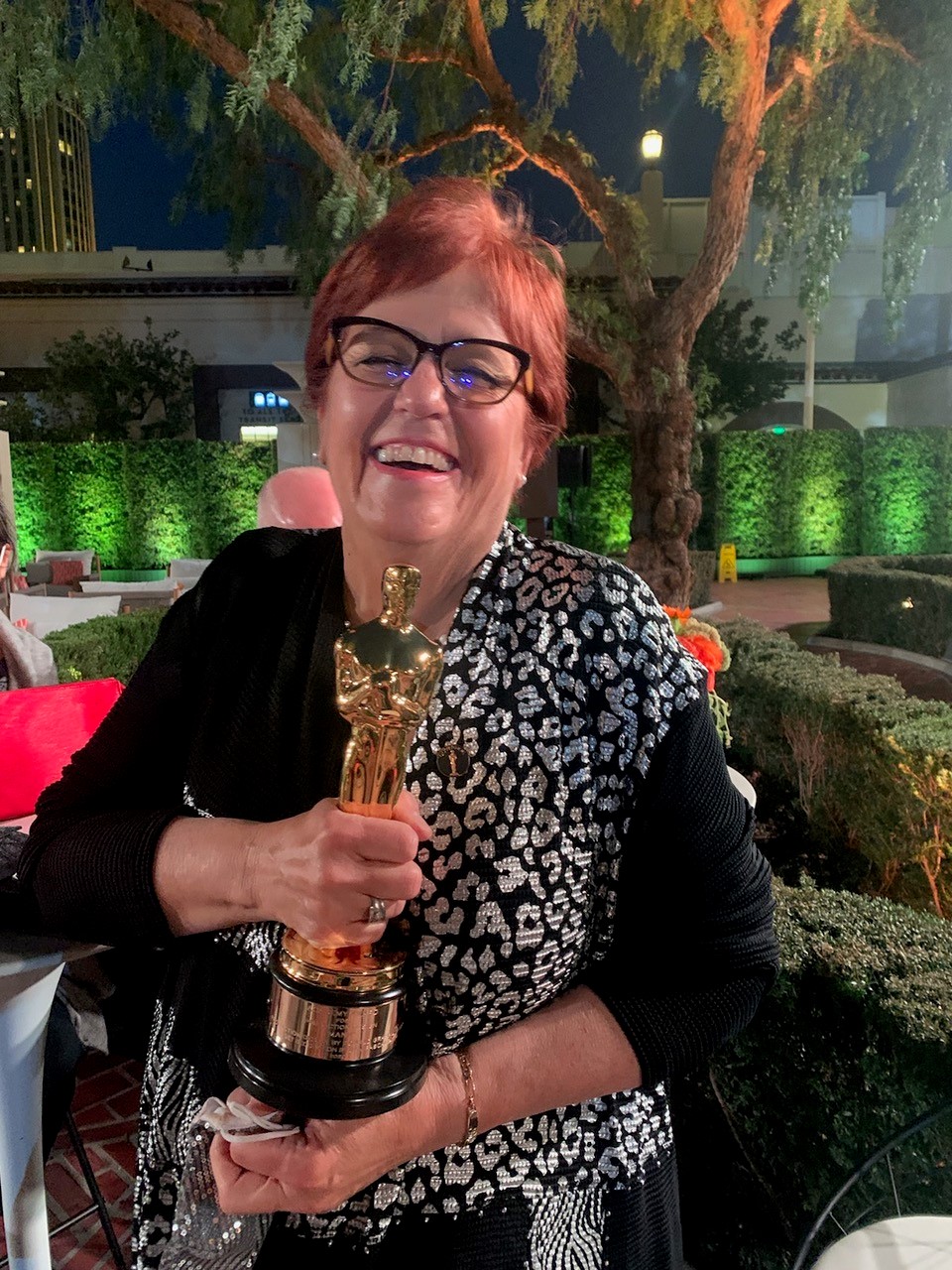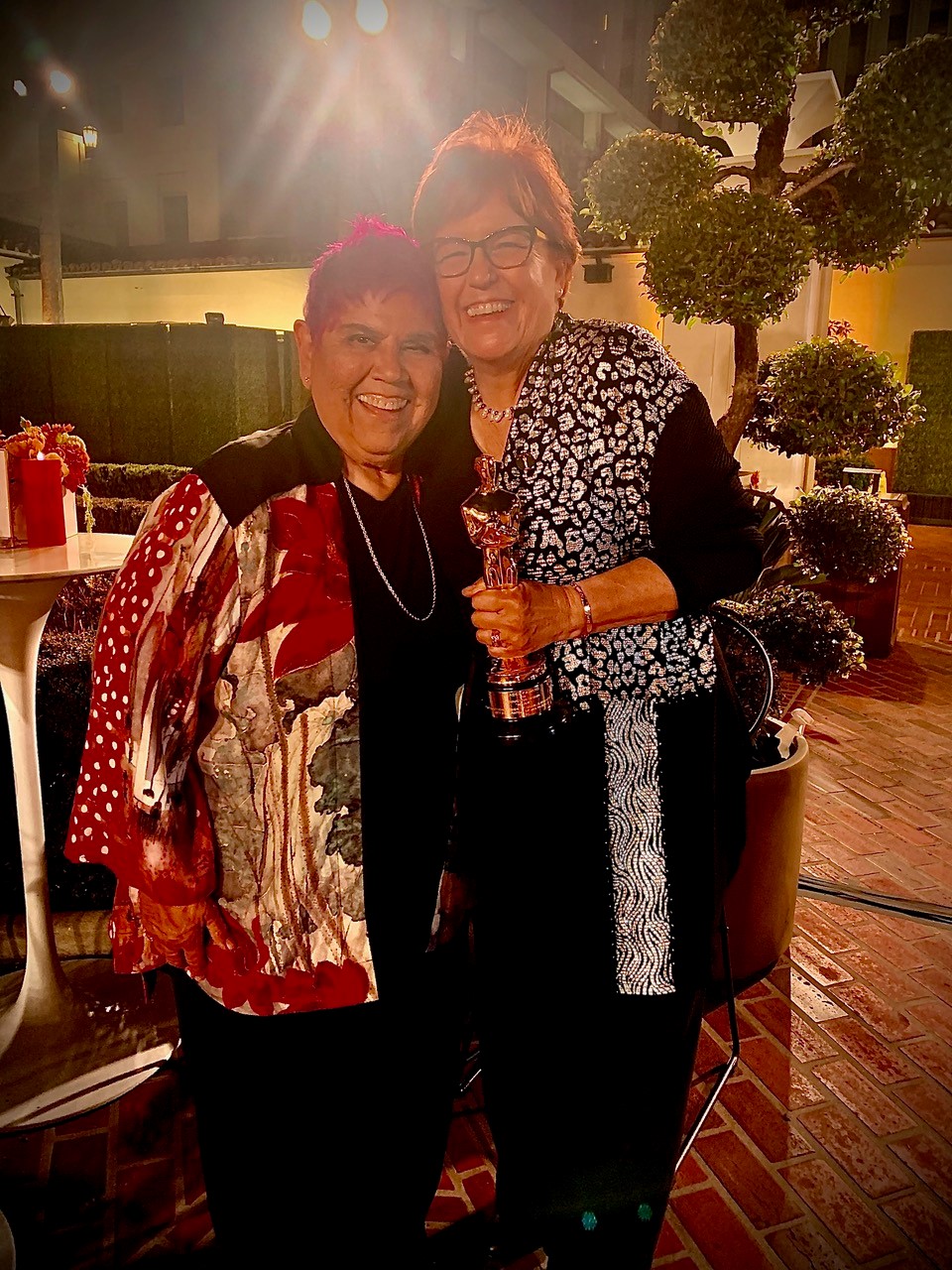Movies loomed large for Jan Pascale. As a child she took over her parents’ basement where she created a world of make belief by building little sets to go along with her stories, so in a way her storied career started very early. She just didn’t know it at the time.
If you watched “Dracula: Dead and Loving It”, ‘The Flinstones in Viva Rock Vegas”, “Boston Public”, “Training Day”, “Anchorman: The Legend of Ron Burgundy”, “Good Night, and Good Luck”, “The Spiderwick Chronicles”, “Four Christmases”, “Horrible Bosses”, ”Veep”(pilot), ”Argo”, “Sicario”, “Nina”, “Suburbicon”, “Syriana”, “S.W.A.T”(pilot) or “Vice”, you have seen just a sample of Sister Pascale’s extensive list of credits. Her incredible talent has been rewarded with an Oscar for her work on “Mank” for Best Achievement in Production Design which she shared with Production Designer Donald Graham Burt.
How did you get your start in show business? Did you plan for it or just fell in it?
In my early twenties, I was working at an unfulfilling job as a retail store manager while surrounded by artistic people like my actress roommate and my boyfriend, who was working at the local PBS station WQED, in Pittsburgh. When they needed help with the sets, I pitched in and enjoyed the experience so much, I quit my retail job. As luck would have it, the production of “Mister Rogers’ Neighborhood” needed a painter/Prop Master and I was hired by Art Director Jack Guest. Under his mentorship, I learned about how to work on set, color and grey scale, what a Prop Master does, etc. In addition to Jack Guest, Production Designers Cletus Anderson and Bruce Miller were also important mentors in the business. Soon I branched out to movies with my first feature work for George Romero. But my real education on set construction, design and staging came from years of work in the theatre. Hollywood came calling when a commercial was filmed locally and I made an impression on my boss because I had every tool needed for the job in my truck. When the commercial had to be finished in Hollywood, I got on the plane with my large kit and crashed with my former actress roommate. After that, I commuted for various jobs between Pittsburgh and Hollywood until I made the move to Hollywood in 1986 and became a member of Local 44 in 1991.
You have been nominated for an Oscar for “Good Night, and Good Luck” another black and white feature. Did that give you a head start in preparation for “Mank” or is each project so unique you start from scratch?
When working on period films, I’ve been nicknamed the “Period Police” by a few Production Designers I have worked with. “Good Night, and Good Luck” had a very tight budget and we couldn’t build or paint very much at all. While “Good Night” was shot on film, it was printed only in black and white. “Mank” was filmed digitally in black and white on the Red camera. Some of the dressing on the sets for “Good Night” were vibrant colors, but the shapes and values were correct. With “Mank”, we tried to keep the sets more subdued, which made it easier for the actors to get a feel for the period. While shopping for “Mank”, my Buyer Joni Indursky and I used the Noir filter on our iPhones to see what our set dressing and fabrics would look like when captured with the Red camera.
Describe some of your experiences in decorating the main sets on “Mank”?
In creating the most expansive sets of the film, the dining room at Hearst Castle and the salon, we relied on old black and white photos of parties at the castle. Prop Master Trish Gallaher Glenn went to San Simeon to have a look at the dining room and discovered that the large (34’) dining table is actually two tables put together, so we worked with Omega Cinema Props’ Elder Lopez and Allan Songer to perfectly match the woodgrain of the table. The chairs were procured through Arte de Mexico and the fabric was located by my fellow Set Decorator David Smith. We had them upholstered by Tony Carillo and the team at Warner Bros Drapery/Upholstery Dept. My Leadman Tony Andraus and our amazing Local 44 crew really rose to the challenge to get all of the details right in not much time, due to our challenging shooting schedule and widespread locations.
What logistics were involved to decorating a period piece like “Mank”?
Working on a period piece on location vs a newly constructed set keeps you on your toes as you have to pay attention to every modern detail from the light sockets, light switches to the lightbulbs, and remove evidence of the 21st century. It is certainly a challenge to find something that is 100 years old but doesn’t look its age. This is when I appreciate the amazing infrastructure Hollywood can offer, where we can find what we need by working with the property shops at Warner Bros, History For Hire, Omega Cinema Props, Universal Studios, and Hand Prop Room, to name just a few. If they didn’t have it, then eBay came to the rescue. It took months to locate the 150-pieces of Blue Willow china, which we bought a couple of pieces at the time until we had enough pieces for multiple takes of the dinner scene. Typewriters from the 1920’s, or rather working typewriters from the 20’s was another great hunt. Some were rented and some purchased, refurbished and brought back to life fully functional. Amazingly, many of the young actors on set had never seen or touched a typewriter.
Which of the productions you worked on was the most challenging?
The 2018 feature “Vice” contained 158 period sets built and filmed in 54 days which spanned the White House and Oval Office through 5 administrations and as many decades.
Which production is your fondest memory and why?
As far as the sentimental one, it would have to be “Argo”. I had a chance to communicate with some of the actual hostages and some of the “Houseguests” that were in hiding in the Canadian Ambassador’s home for 14 months. Their harrowing stories brought the film to life and their experiences have stayed with me to this day. With the exception of a few days on location in Washington DC, and 4 days in Turkey, the movie was filmed entirely in Los Angeles, which also doubled for Tehran.
Is there a genre that you haven’t worked on that you would love to have a crack at it?
Working on a Western has alluded me so far but hope springs eternal.
You have collaborated with many filmmakers over the years, which one always excites you when you get the call?
I’m always excited when I get a call and have enjoyed working with many great directors. I’ve collaborated more than once with George Clooney and director Adam McKay and consider making Will Ferrell laugh twice a career highlight. And of course working with David Fincher was an amazing experience. His precision and focus were an inspiration.
If you could chat with your younger self, what would be the most important advice you would give yourself or anyone new starting in the industry?
Listen, pay attention, observe situations, watch people’s habits, which will make the environment you re-create more authentic. One of the rules I live by for every set is that it should look “lived in” and I love building “character’ in the environments to help support the story. But the one piece of advice I would give my younger self is to toughen up a little sooner.
What are your plans for the foreseeable future?
I look forward to the many stories yet to be told and being part of the collaborative process of filmmaking. I never imagined I would work in the movie business or have such a long and productive career. I feel very fortunate to have had such a wonderful journey with my wife Louise del Araujo who was also my Lead Woman for 25 years before she retired.
Last but not least the most important question of all. Have you picked a place of honor for your Oscar?
The latest addition to the “awards family’ has taken up residence on the home entertainment unit next to the Emmy I won for “Boston Public” in 2001. I am still getting used to having won an Oscar and pleasantly surprised to see him gleaming first thing in the morning. When not on the shelf, Oscar has accompanied me to the set of the latest Disney+ Series “Obi-Wan Kenobi” as many of the “Mank” crewmembers are working with me on the sci-fi series.
Local 44 congratulates Sister Pascale on her Oscar win and thank her for taking the time from her busy schedule to chat with Newsreel.
 Set Decorator Jan Pascale - Winner of Best Production Design for "Mank"
Set Decorator Jan Pascale - Winner of Best Production Design for "Mank"
 Louise del Araujo, retired Local 44 Lead (Jan's wife) and Jan Pascale
Louise del Araujo, retired Local 44 Lead (Jan's wife) and Jan Pascale
 Crew of "Mank"
Crew of "Mank"
Back row (left to right): Chance Quinn, Steve Hull, Buyer Joni Indursky, Leadman Tony Andraus, Set Dec Coordinator (Local 871) Canada Gordon, Jan Pascale, Howard Miller, Matt Atzenhoffer, Robbie Ford, Cheyanne Lee, Deborah Harman
Middle to front (left to right): Nick Zepatos, Lonnie (Armando) Alvarado, Rodney Cinkan (Local 729), Jonathan Felix
Not pictured: Katie Gauvin, Matthew Vanborg, Tony (Tio) Carillo, Frank Camara, David Venezky, Darrell Vangilder, Chris Larsen, Ed Protiva, Reid Embrey, Eddie Tamayo, Nikolai Lovekis, Tim Gideon, Mike Thurman, Adrian Abarca, Andrea Fiorentini, Property Master Trish Gallaher Glenn, and Props team: Monica Castro, Jeffrey Lombardi, Teri Lane, Michael Vines, Briana Winchell, Construction Coordinator Jeff Goyer, General Foreman Marcel Worch and their teams.


